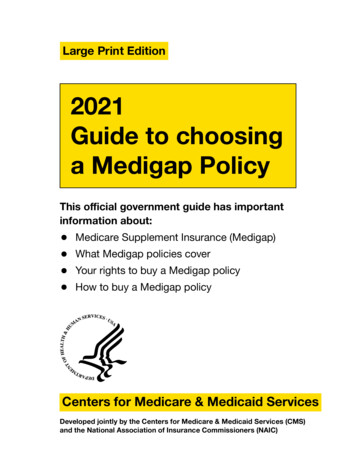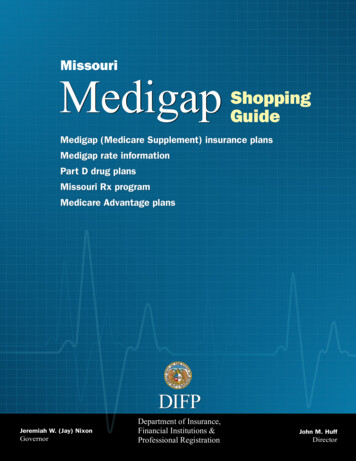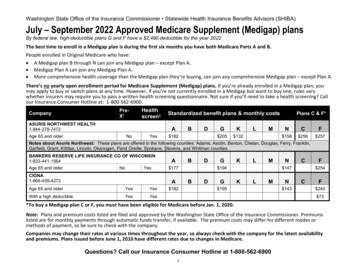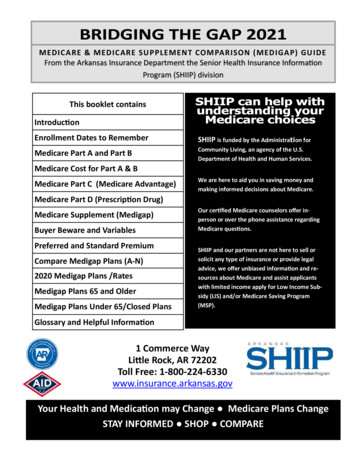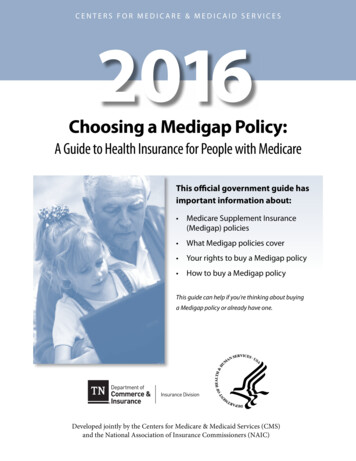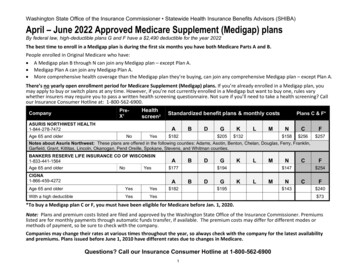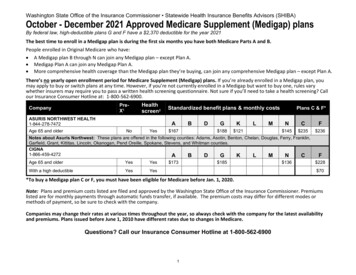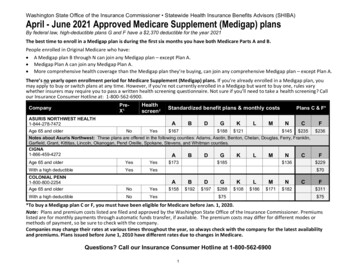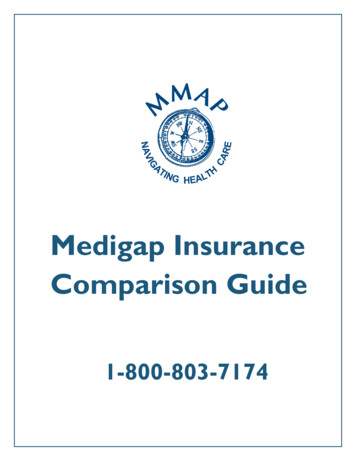
Transcription
Medigap InsuranceComparison Guide1-800-803-7174
TABLE OF CONTENTSAbout This Publication . 5About MMAP . 6What is Medicare? . 7What are my Medicare plan options?. 7What is a Medigap policy? . 9Why buy a Medigap policy? . 10What doesn’t a Medigap policy cover? . 11What does a Medigap policy cover? . 11How much does a Medigap policy cost? . 11What should I think about before buying a Medigap policy? . 12How do I shop for a Medigap policy? . 13When is the best time to buy a Medigap policy? . 13What is creditable coverage? . 14Should I start my Medigap open enrollment period if I am age 65 orolder and still working? . 15How can I tell if I’m in my Medigap open enrollment period? . 15What if I missed my Medigap open enrollment period? . 16What if I have Medicare and am under age 65? . 16Should I be aware of other health insurance options? . 17How has legislation changed Medigap policies? . 18What is Medicaid and how can it help? . 193
What if I have a Medigap policy and then receive Medicaid? . 19What is Medigap insurance fraud and how can I protect against it?. 20What do Medigap Plans cover? . 22What do Medigap Plans K and L cover? . 23The 10 Standardized Medigap Plans . 25Medigap Insurance Comparison Chart. 26Medigap Insurance Comparison Chart Worksheet . 30Glossary . 32Notes . 394
ABOUT THIS PUBLICATIONThe Michigan Medicare/Medicaid Assistance Program (MMAP pronounced ‘map’) developed this publication for people withMedicare, their families and caregivers. This guide will help youfigure out the what, why, when, where, and how of Medigapinsurance.By the end of this publication, you will learn: What a Medigap policy is. Why you might want to buy a Medigap policy. When you can buy a Medigap policy. Where you can find more information. How to choose the Medigap policy that best fits your needs.This guide is for informational purposes only. Please doublecheck costs and coverage information before purchasing aMedigap policy. You can verify the information by contactinginsurance companies directly.Please call your local MMAP office (1-800-803-7174) when youfinish reading this publication. A counselor in your community willhelp you with your remaining Medigap insurance questions andconcerns. This assistance is free for all people with Medicare, theirfamilies and caregivers.5
ABOUT MMAPThe Michigan Medicare/Medicaid Assistance Program (MMAP) is afree service that can help you make health insurance decisions.MMAP’s mission is to educate, counsel, and empower Medicarebeneficiaries and those who serve them so that they can makeinformed health benefit decisions. MMAP is an independentprogram funded by state and federal agencies. It is not affiliatedwith the insurance industry. Nationally, this program is called theState Health Insurance Assistance Program (SHIP). There is a SHIPin each state, the District of Columbia and the U.S. Territories.When you call the MMAP 1-800-803-7174 hotline, you will belinked to a counselor in your community. Your counselor can helpyou: Understand Medicare and Medicaid. Compare or enroll in Medicare Prescription Drug Coverage. Review your Medicare supplemental insurance needs. Understand Medicare health plans. Apply for Medicaid or a Medicare Savings Program. Explore long term care insurance options. Report medical identity theft. Understand and report Medicare and Medicaid fraud or abuse. Be aware of current scams and health care fraud.6
WHAT IS MEDICARE?Medicare is a federal health insurance program for people age 65 orolder, people under age 65 who have certain disabilities, and peopleof all ages with End Stage Renal Disease (ESRD), a permanentkidney failure requiring dialysis or a kidney transplant.Medicare has several parts, including: Part A (Hospital Insurance) – Helps pay for inpatient hospitalcare, limited skilled nursing care, hospice care, and somehome health care. Most people get Medicare Part Aautomatically when they turn 65. Part B (Medical Insurance) – Helps pay for doctors' services,outpatient hospital care, and some other medical services thatMedicare Part A does not cover. You must pay a monthlypremium to receive Medicare Part B. Part C (Medicare Advantage Plans) – A way to receive yourMedicare benefits through a private insurance company.Medicare Advantage will be described in detail on page 9. Part D (Prescription Drug Coverage) – Helps pay forprescription drugs, insulin, some injections, and diabeticsupplies used to inject insulin. You must pay a monthlypremium to receive Medicare Part D.WHAT ARE MY MEDICARE PLAN OPTIONS?There are different ways you can get your health care andprescription drug coverage through the Medicare program. You canchoose either Original Medicare or a private Medicare AdvantagePlan. If you choose Original Medicare, then you might benefit from aMedigap policy. However, if you have a Medicare Advantage Plan,you won’t need Medigap because your plan should already providemany of the benefits a Medigap policy would cover.Your Medicare plan affects your health care in many ways,including cost, benefits, doctors, convenience, and quality. No7
matter how you choose to get your health care, you are still in theMedicare program.Original Medicare – If you have Original Medicare, you will receiveyour Medicare Part A and B benefits from the federal government.You can use Original Medicare to get health care services andsupplies nationwide and can use any provider that acceptsMedicare.You can buy a Medigap policy to pay for Original Medicaredeductibles, co-payments, and coinsurance amounts. You may alsopurchase a Medicare Part D plan to cover the cost of yourprescriptions.Medicare Advantage (MA) Plan – If you have a Medicare AdvantagePlan, you still receive your Medicare Part A and Part B benefits.However, you will receive your health coverage benefits from aprivate insurance company instead of the federal government. TheMedicare Advantage Plans are a different way of receiving yourhealth benefits. Some Medicare Advantage Plans include Part Dprescription drug coverage. Some may also provide extra benefits,such as free gym memberships or limited vision coverage.Medicare Advantage Plans may cover many of the same benefitsthat a Medigap policy would cover, such as extra days in thehospital. For this reason, you may not have a Medigap policy and aMedicare Advantage Plan at the same time.You must have both Medicare Part A and Part B to join a MedicareAdvantage Plan. You will still pay the Medicare Part B premium of 134.00 per month (in 2018). In addition, you may also have to paya monthly premium for your Medicare Advantage Plan. Before youjoin a Medicare Advantage Plan, you should call the company tofind out how much your monthly premium, copayments anddeductibles for services would be. Monthly premiums may vary byzip code.Medicare Advantage Plans are available in many areas, but mayrequire you to use a specific network of providers for non8
emergency care. The network may be local, regional, or nationwide.The size of the network depends upon the type of MedicareAdvantage Plan you choose. Before you pick a MedicareAdvantage Plan, you should contact all of your health careproviders to make sure they participate in the plan’s network.There are five types of Medicare Advantage Plans: Medicare Health Maintenance Organization (HMO) Plans Medicare Preferred Provider Organization (PPO) Plans Medicare Private Fee-for-Service (PFFS) Plans Medicare Special Needs Plans (SNP) Medicare Medical Savings Account (MSA) PlansFor more information on Medicare Advantage Plans contact MMAPat 1-800-803-7174 or Medicare at 1-800-633-4227 orwww.medicare.govYou must have Medicare Part A and Part Bto purchase a Medigap policy.WHAT IS A MEDIGAP POLICY?A Medigap policy is health insurance sold by private insurancecompanies to fill the “gaps” in Original Medicare. For instance,Medigap policies may help pay for your Original Medicaredeductibles, co-payments, or coinsurance.Medigap policies are also called “Medicare SupplementalInsurance.” When you buy a Medigap policy, you pay a premium tothe insurance company for your plan. The policy will beautomatically renewed each year as long as you pay your premium(unless the policy was purchased before 1991).9
There are 10 different Medigap policies you can choose from,labeled Plans A through N. The Medigap policies are “standardized”so that you can easily compare plans sold by different insurancecompanies (except in Massachusetts, Minnesota, and Wisconsin).Each type of Medigap policy covers the same benefits no matterwhat company sells it. For example, if you buy Plan A fromInsurance Company 1, the policy will offer the same benefits asPlan A sold by Insurance Company 2. You will receive the samePlan A benefits no matter which company you purchase from. Theonly difference is premium cost.Because Medigap policies supplement Original Medicare, it ishelpful to understand Medicare and your Medicare plan choicesbefore you learn the details about Medigap. For that reason, thisguide will first describe Medicare and your Medicare plan choices.Then, it will explain Medigap and your Medigap insurance options.Finally, this guide also includes a glossary that may help youunderstand the insurance terms and concepts you will readthroughout the guide.When you buy a Medigap policy, it only covers yourhealth care costs. It does not cover anyhealth care costs for your spouse.WHY BUY A MEDIGAP POLICY?A Medigap policy can be a good option for people who want extrabenefits, want to minimize their out-of-pocket costs, and can affordto pay a monthly Medigap premium. Original Medicare pays formany health care services, but it does not pay for all of your healthcare costs. There are certain costs that you must still pay, includingcoinsurance, co-payments, and deductibles. These costs are called10
“gaps” in Medicare coverage. You may want to buy a Medigap policyto cover these gaps in Medicare coverage and save money on yourout-of-pocket costs. Some Medigap policies also provide extrabenefits that aren’t covered by Medicare, such as routine annualcheck-ups and emergency health care while traveling outside theUnited States.If you have retiree health coverage through your or your spouses’former employer, you may not need a Medigap policy. Please checkwith your MMAP Counselor or retiree benefit administrator for moreinformation.WHAT DOESN’T A MEDIGAP POLICY COVER?Some benefits are never covered by Medigap policies, including: Long-term care Hearing aids Vision or dental care Private-duty nursing Prescription drugsWHAT DOES A MEDIGAP POLICY COVER?Each Medigap policy must cover the basic set of benefits. Thesebenefits are listed on pages 24-26. These basic benefits includemost Original Medicare coinsurance amounts, blood, and additionalhospital benefits not covered by Original Medicare. Some Medigappolicies may also pay for the Original Medicare deductibles or other“gaps” in Medicare coverage. The chart on page 27 shows thebenefits offered by the 10 standardized Medigap policies.HOW MUCH DOES A MEDIGAP POLICY COST?The cost of a Medigap policy varies, depending upon which Medigapplan and insurance company you choose. The chart on pages 29-3111
shows examples of the annual cost of Medigap policies offered bysome insurance companies in Michigan. The cost of purchasing apolicy from one of these companies ranges from 388 to 5,598 peryear. The cost may also vary based upon how an insurancecompany sets prices for its Medigap policies. There are threedifferent ways that insurance companies price their Medigappolicies, including: Community Rated – The cost of the policy is based upon thecommunity in which you live. Your premium is set accordingto how much it costs the company to provide Medigapcoverage in your area. Everyone in the plan pays the samepremium regardless of age, health, or length of time in theplan. Issue Age – The cost of the policy is based upon how old you arewhen you first purchase the policy. Your premium will notincrease simply because you have a birthday. Attained Age – The cost of the policy is always based upon yourcurrent age. This means that your premium will increase asyou grow older. Some companies may increase your premiumannually, while others may use “age bands”. This means thatyour premium increases based upon an age category or group(e.g. every five years). Attained age policies generally start outless expensive than issue age policies and grow moreexpensive as you get older.It is important to understand how a company sets its prices beforeyou purchase a Medigap policy. The way a company prices itspolicies will affect how your premium increases over time.WHAT SHOULD I THINK ABOUT BEFORE BUYING A MEDIGAPPOLICY?You may want to consider these questions: How much am Ispending on health care? What are my health care dollars spent on?Which Medigap benefits do I need? How much can I afford to spend12
on premiums? What might my future health care costs be?Remember, you may need more health care as you get older.HOW DO I SHOP FOR A MEDIGAP POLICY?Here are a few tips for shopping for a Medigap policy: Remember, each type of Medigap policy covers the samebenefits no matter what company sells it. The only differencebetween the policies is cost. Review Medigap Plans A – N and choose the plan that has thebenefits you want (see page 27). Shop carefully. Call several insurance companies about theplan(s) you may want. Compare costs before you buy. Don’t let an insurance agent rush you into buying a policy.You can always ask for more time to think about it and callthem back. Don’t buy more than one Medigap policy at a time. Don’t pay in cash. Pay only by check, money order, or bankdraft made payable to the insurance company, not to theinsurance agent or anyone else.Remember to double-check any cost and coverageinformation before you purchase a Medigap policy.You can verify these details by calling theMedigap insurance company.WHEN IS THE BEST TIME TO BUY A MEDIGAP POLICY?The best time to buy a Medigap policy is during your six monthMedigap open enrollment period, which begins on the first day ofthe month in which you are both: Age 65 or older, and13
Enrolled in Medicare Part BYou will only have the opportunity for one Medigap openenrollment period. You may delay the start of your Medigapopen enrollment period, but once it starts it cannot be stoppedand you will not get another.During your Medigap open enrollment period, an insurancecompany cannot: Deny you Medigap insurance coverage. Place conditions on a Medigap policy, like making you wait forcoverage to start. Change the price of a Medigap policy because of your past orpresent health conditions.There is one more advantage to buying a Medigap policy duringyour open enrollment period - the policy may cover yourpre-existing health conditions without a waiting period. (Apre-existing condition is a health condition you had before yourMedigap coverage began). If you buy a Medigap policy outside ofyour open enrollment period, an insurance company can make youwait up to six months before it will cover your pre-existingconditions. However, you can reduce this waiting period if you havecreditable coverage.WHAT IS CREDITABLE COVERAGE?Creditable coverage is health coverage you had before you appliedfor a Medigap policy. If you buy a Medigap policy during your openenrollment period, creditable coverage can reduce the time you haveto wait before your pre-existing health condition(s) will be coveredby your Medigap policy.Some examples of creditable coverage include: Employer or union group health plans Medicare Part A or Part B14
Medicaid TRICARE Indian Health Service Federal Employees Health Benefit Plan (FEHBP) Consolidated Omnibus Budget Reconciliation Act (COBRA)(if previous employer coverage was creditable) A public health plan A private health insurance policyAn insurance company must reduce your pre-existing conditionwaiting period by one month for each month of your creditablecoverage. For example, if you have four months of previouscreditable coverage, your waiting period will be reduced by fourmonths. This means you will only have to wait two months beforeyour Medigap policy will cover any pre-existing health conditions.SHOULD I START MY MEDIGAP OPEN ENROLLMENT PERIOD IF IAM AGE 65 OR OLDER AND STILL WORKING?You may choose to wait to enroll in Medicare Part B if you still havehealth coverage through your employer. If you delay yourenrollment in Medicare Part B you also delay the start of yourMedigap open enrollment period because it won’t start until you are65 and you sign up for Medicare Part B. It may be worth waitingbecause, once your open enrollment period starts, you can neverhave another.HOW CAN I TELL IF I’M IN MY MEDIGAP OPEN ENROLLMENTPERIOD?You can tell if you are in your Medigap open enrollment period bylooking at your Medicare card. The lower right corner of this cardshows the dates that your Medicare Part A and Part B coveragebegan. If you are age 65 or older, add six months to the date that15
your Medicare Part B coverage started. If the date is in the future,you are still in your Medigap open enrollment period. If the date isin the past, you have missed your Medigap open enrollment period.WHAT IF I MISSED MY MEDIGAP OPEN ENROLLMENT PERIOD?You can still apply for a Medigap policy. However, Medigapinsurance companies are allowed to use medical underwriting todecide whether to accept your application, and how much to chargeyou for your Medigap policy.You may sometimes have a special right to purchase a Medigappolicy from any insurance company, even if you are no longer inyour Medigap open enrollment period. This is called a “guaranteedissue right.” You may be eligible for a guaranteed issue right if youhave a major change in your health insurance coverage. If you havea guaranteed issue right, you are entitled to a special Medigapenrollment period in which insurance companies must sell you aMedigap policy, must cover your pre-existing conditions, and maynot charge you more because of your health conditions. These arevery similar to the protections that you have while you are in yourMedigap open enrollment period. Please contact MMAP to see if youmay be eligible for a Medigap guaranteed issue right.WHAT IF I HAVE MEDICARE AND AM UNDER AGE 65?If you are under age 65 and already have Medicare, you maypurchase a Medigap policy at any time. In Michigan, insurancecompanies who sell major medical policies must offer Plans A and Cto people under 65 with Medicare. Any company selling onlysupplemental insurance is not required to sell the A and C Plans topeople under age 65 who have Medicare due to a disability.However, most companies are allowed to charge more because ofpast or present health conditions. They may also require a six-16
month pre-existing condition waiting period before they will covercertain health conditions.Michigan LawSome insurance companies must offer MedigapPlans A and C to people with Medicare at any time,regardless of their age or health status.People who are under age 65 and have Medicare will also be eligiblefor the regular six-month Medigap open enrollment period whenthey turn 65. During this enrollment period, they will have the rightto buy any Medigap policy and may not be denied coverage orcharged more because of pre-existing health conditions.SHOULD I BE AWARE OF OTHER HEALTH INSURANCE OPTIONS?Yes, you may want to compare three other health insurance optionsto the Medigap policies.Medicare SELECT – Medicare SELECT is another type of Medigappolicy that offers lower premiums but limits the network of doctorsand hospitals you can use, except in an emergency. If you choose aMedicare SELECT policy, you are buying a standardized Medigapplan, labeled A through N. However, if you use an out-of-networkprovider for non-emergency services, you will have to pay the coststhat Medicare doesn’t pay. Medicare will still pay its share of theapproved costs, as long as the provider accepts Medicare. Please seepages 29-31 for details about some Medicare SELECT policies soldin Michigan.Medicare Advantage – Medicare Advantage Plans generally covermany of the same benefits as Medigap policies. For this reason, youshould not have a Medigap policy and a Medicare Advantage Plan atthe same time. Medicare Advantage Plans may have lowerpremiums than Medigap policies. However, you may have to use a17
network of providers and pay different co-payments, coinsurance,or deductibles than people in Original Medicare.Employer/Retiree Coverage – You may already have employer orretiree coverage that could pay for some or all of the Medicare copayments, coinsurance, and deductibles typically covered by aMedigap policy. If you have an employer or retiree group healthplan, your employer’s benefits administrator can best answerquestions about your coverage.HOW HAS LEGISLATION CHANGED MEDIGAP POLICIES?Two laws have changed the types of Medigap policies available andthe benefits offered by some Medigap policies. The first law was theMedicare Modernization Act (MMA) of 2003, which created MedicarePart D and eliminated the need for the prescription coverage offeredby Medigap Plans H, I, and J. If you already have one of theseMedigap policies, you have two options:(1) You can keep your policy without prescription coverage, or(2) You can keep your policy with prescription coverage, as longas you don’t enroll in Medicare Part D. If you choose to enrollin Part D later, you will pay a late enrollment penalty.The Medicare Improvements for Patients and Providers Act (MIPPA)of 2008 impacted Medigap policies by eliminating several plans,creating new plans, and altering the benefits provided by someplans. Beginning in June 2010, MIPPA eliminated Medigap Plans E,H, I, and J. These plans are now outdated due to improvements inMedicare coverage over the past two decades. If you are enrolled inone of the eliminated plans you may keep your policy. MIPPA alsoremoved some benefits from Medigap policies, including at-homerecovery and preventive care.Finally, MIPPA created two new Medigap policies, labeled Plans Mand N. Plans M and N offer many of the same benefits as otherMedigap policies, but with slightly different cost-sharing. For detailson these plans please refer to the chart on page 27.18
WHAT IS MEDICAID AND HOW CAN IT HELP?Medicaid is a program that helps pay medical costs for some peoplewith low income and limited resources. There are different types ofMedicaid programs, some of which offer “full” or “partial” help topeople with Medicare. Full Medicaid coverage fills the gaps inMedicare and may also provide additional benefits that are nevercovered by Medicare (e.g. vision). If you have Medicare and fullMedicaid, you may not need to purchase a Medigap policy. OtherMedicaid programs offer partial help to people with Medicare. TheseMedicare Savings Programs may pay for some, or all, of Medicare’spremiums, deductibles, co-payments, and coinsurance amounts. Toqualify for a Medicare Savings Programs, you must have: Medicare Part A Countable monthly income of 1,385.75 or less for anindividual or 1,871.75 or less for a couple (effective 4/1/18 –changes annually) Savings of 7,390 or less for an individual or 11,090 for acouple (in 2018) Savings include cash, money in a checking or savings account,and investments like stocks or bondsFor more information about these Medicaid programs, you can callMMAP at 1-800-803-7174. You can also call your countyDepartment of Health and Human Services office. The phonenumber is listed in your phone book under County or StateGovernment.WHAT IF I HAVE A MEDIGAP POLICY AND THEN RECEIVEMEDICAID?If you purchase a Medigap policy and later receive Medicaid, youwill have the right to suspend your Medigap policy for two yearswhile you are on Medicaid. If you exercise this right, you will nothave to pay premiums and the policy will not pay benefits. At the19
end of the suspension, you can start your policy again without anynew medical underwriting or pre-existing condition waiting periods.You can call your Medigap insurance company to find out how tosuspend your policy.WHAT IS MEDIGAP INSURANCE FRAUD AND HOW CAN I PROTECTAGAINST IT?Insurance agents and companies are not allowed to make false ormisleading statements or leave out important facts about insurancepolicies. This is considered insurance fraud. When you buy aninsurance policy, you trust the insurance agent and writtenmaterials to truthfully explain what the policy does and does notcover. The Michigan Uniform Trade Practices Act requires insuranceagents and companies to give you accurate information about anypolicy they sell. It is fraudulent for an agent or company to: Misrepresent what a policy covers or does not cover. Misrepresent the advantages or disadvantages of a policy. Make a false statement to persuade you to cancel or exchangea policy you already have. Make an incomplete comparison of insurance policies. Use a name or title for a policy that misrepresents the contentof the policy. Make a false or misleading statement about the financialstrength of an insurance company. Make a false or misleading statement to get you to transfer thevalue of your policy to someone else or to take out a loanagainst your policy. Misrepresent an insurance policy as an asset that can betraded or sold for investment purposes. Sell a Medigap policy to someone who has Medicaid orMedicare Advantage.20
To protect against Medigap insurance fraud, you should: Research Medigap Plans A – N so you know what is availablebefore you buy a policy. Decide what benefits you would likeyour Medigap policy to cover. Read any literature about the policy you are considering andmake sure you know what you are buying. It is important toknow what is covered by the policy and what is not covered. Ask questions. Don’t be afraid to ask questions or take theagent’s time. He or she will be earning a commission on thepolicy you buy. Deal with a reputable agent. If possible, get references fromother customers to find out if they were satisfied with theservice and coverage they received. Take your time in making a decision. An insurance policy canbe very valuable to you if you have to make a claim. It isimportant that you know what will or will not be covered byyour policy. Do not allow an insurance company or agent topressure you into enrolling. Get it in writing. If an agent tells you that something iscovered and you don’t see it in the policy, ask him or her toshow you in writing where it is covered in the policy. Keep therecord for later. Before you sign any form, read it and make sure youunderstand what it means. If you don’t understand, askquestions. This is an important decision, so take your timeand don’t rush.21
Do not pay in cash. Pay only by check, money order, or bankdraft made payable to the insurance company, not to theinsurance agent or anyone else.If you think you have been a victim of insurance fraud,please contact the Michigan Department of Insurance andFinancial Services (DIFS) at 1-877-999-6442You can also contact MMAP for assistanceat 1-800-803-7174WHAT DO MEDIGAP PLANS COVER?Medigap Plans A – N have a Basic or Core benefit. Each planincludes at least this basic benefit; however, plans K and L offerslight alterations in the basic benefit. The basic benefit covers: Medicare Part A Coinsuranceo Days 61-90 of a hospital stay in each Medicare benefitperiod ( 335 per day in 2018)o Days 91-150 of a hospital stay ( 670 per day in 2018)Medicare will only pay for these 60 days once during yourlifetime. If you are hospitalized again, you (or yoursupplemental insurance) will have to pay for days 91-150 Medicare Part A Hospital Benefitso An extra 365 days of inpatient hospital care after you useyour Original Medicare hospital benefits Medicare Part B Coinsurance or Copaymento Medigap pays for the Part B coinsurance after you meetyour 183 (in 2018) annual deductible Medicare Part A and B Blood Coverage22
o First three pints of blood (or equivalent quantities ofpacked red blood cells) per calendar year Medicare Part A Hospice Care Coinsurance or Copaymento Medigap pays outpatient prescriptions drug and inpatientrespite care coinsuranceIn addition to the basic benefits Plans A – N offer a variety ofadditional benefits in various combinations. Please see the chart onpage 27 for details on these combinations.WHAT DO MEDIGAP PLANS K AND L COVER?Medigap Plans K and L cover the same “gaps” in Medicare as thebasic benefit. However, Plans K and L do
Medigap policies may help pay for your Original Medicare deductibles, co-payments, or coinsurance. Medigap policies are also called "Medicare Supplemental Insurance." When you buy a Medigap policy, you pay a premium to the insurance company for your plan. The policy will be automatically renewed each year as long as you p ay your premium
